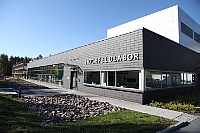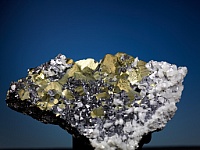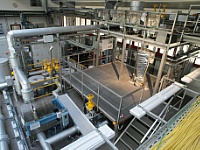Online Annual Report 2012
Calendar of Events
 January: A New European Record
January: A New European Record
Scientists from the Dresden High Magnetic Field Laboratory (HLD) improved their own European record from 91.4 Tesla to 94.2 Tesla. The record breaking coil was developed in the HLD’s workshop and is surrounded by a thinner stainless steel cylinder that was then additionally encased by the reinforcement fiber Zylon®. This slight change made it possible to generate an even higher magnetic field with the same 16 millimeter diameter borehole of the coil.
February: Continued Education in Magnets
Like every year, teachers from all over Saxony came to the HZDR to inform themselves of the current state of research and science – this time, in the field of magnetohydrodynamics. Scientists from the Institute of Fluid Dynamics presented their research work which ranges from fundamental research to cosmic magnetic fields all the way to controlling magnetic fields in cast steel or aluminum. More than 80 instructors participated.
March: Employee Event to Celebrate Anniversary
On March 15, the HZDR celebrated its 20th anniversary in the Technische Sammlungen Dresden with a special afternoon in the technical museum for all employees. On display was also the Helmholtz Association’s traveling exhibition “Wunderkammer Wissenschaft” with several hundred thrilling images depicting scientific research.
 April: Lease Agreement for Institute Building
April: Lease Agreement for Institute Building
In the spring of 2014, the staff members of the Helmholtz Institute Freiberg for Resource Technology (HIF) will work in their own offices and labs located in the Chemnitzer Straße in Freiberg. The building is currently being renovated completely. On April 19, 2012, the lease agreement was signed. The HIF is housed temporarily in the Halsbrücker Straße.
May: Dresden Helmholtz Research School NANONET
In order to promote the next generation of excellent scientists for the microelectronics venue Dresden, the new graduate school NANONET (International Helmholtz Research School for Nanoelectronic Networks) was established. It was founded jointly by the HZDR, the Technische Universität Dresden, the Leibniz Institute of Polymer Research Dresden, the Fraunhofer Institute for Nondestructive Testing, and the NaMLab gGmbH corporation. It is funded by the Initiative and Networking Fund of the Helmholtz Association.
June: Excellent University, Excellent Projects
On June 15, 2012, the TU Dresden joined the ranks of the German Universities of Excellence. The requisite funding totaling millions is intended for the university’s concept for the future as well as three additional projects which the HZDR is also participating in: The two clusters of excellence “Center for Advancing Electronics Dresden” and “Center for Regenerative Therapies Dresden” as well as the “Dresden International Graduate School for Biomedicine and Bioengineering.”
 July: Launch of Research Alliances
July: Launch of Research Alliances
In 2012, the HZDR succeeded in setting up two large research networks which are funded by the Helmholtz Association. The Helmholtz Energy Alliance “Energy Efficient Chemical Multiphase Processes” commenced with its work in July. In October, the Helmholtz Alliance LIMTECH began work on the topic liquid metal technologies. Both alliances are coordinated at the HZDR.
August: Focusing on Acceleration Technologies
The accelerator center DESY in Hamburg held the first workshop of the Helmholtz Association’s “ARD” (Accelerator Research & Development) initiative. Six Helmholtz centers located in Hamburg, Dresden, Jülich, Darmstadt, Karlsruhe, and Berlin are working together with two Helmholtz institutes, eleven universities, two Max Planck institutes, and the Max Born Institute in order to strengthen research in the field of accelerator physics and technologies and to assure international competitiveness.
September: Summer Student Program Initiated
Ten students from Europe, Asia, and Africa spent their summer at the HZDR and investigated current research topics in the sectors health, matter, and energy. They also attended lectures of HZDR scientists, participated in tours through the center, and presented their research work in the institutes. The Summer Student Program will be continued in 2013.
 October: “Exemplary Training Institution”
October: “Exemplary Training Institution”
The President of the Dresden Chamber of Industry and Commerce (IHK), Dr. Günter Bruntsch, praised the HZDR as an “exemplary training institution.” The center has been committed to vocational training for 20 years now and successfully trained approximately 180 young women and men during this time. Currently, apprentices can select from among eleven different occupations; and there are also apprenticeship positions for students from the dual studies programs at the universities of cooperative education in Dresden and Riesa.
November: The First ATAS Workshop
A new international forum seeking to discuss experimental and theoretical research in the field of radioactive heavy metals premiered at the HZDR. The first workshop for the application of spectroscopic technologies for researching actinides ("Advanced Techniques in Actinide Spectroscopy“ ATAS) was attended by approximately 75 participants from Europe, the USA, Australia, China, and Japan.
December: A New Supercomputer
In December, the HZDR’s supercomputer Hypnos finally became fully operational; theoretically, it now permits 334 trillion arithmetic operations per second. This equals a computing power which is about 6,000 times higher than that of 2002. The computer, one of the most powerful supercomputers in Saxony, was officially inaugurated with a colloquium in December. And the HZDR’s Computing Center was also modernized and expanded substantially.

